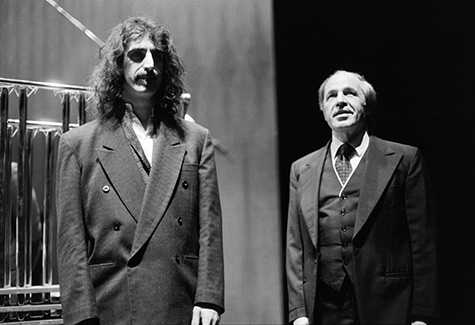Obituary: Pierre Boulez, 1925-2016
Matthew Lorenzon

Frank Zappa, Pierre Boulez, 1984
The composer and conductor Pierre Boulez died on 5 January at the age of 90. His 90th birthday was celebrated with a flurry of box-sets and articles stressing the two sides of this influential but divisive figure. On the one hand, there is the enfant terrible who entered Messiaen’s analysis class after the Second World War and, in Messiaen’s words, “quickly became angry at the entire world.” Boulez the avant-garde iconoclast urged his readers to “burn down the opera houses” and famously claimed that those who did not feel the necessity of the Second Vienese School were “USELESS.” At the same time he scolded the school’s founder Arnold Schoenberg for not following the consequences of his own dodecaphonic technique far enough.
On the other hand, Boulez is remembered as the generous teacher and conductor who fostered into being some of Paris’ iconic musical institutions into being including Ircam (the Institute for Research and Coordination in Acoustics/Music), the Cité de la Musique, and the Philharmonie de Paris. As a conductor he is remembered for the analytical clarity of his direction and his transparent orchestral balance. His recordings reveal the detail of Debussy, Ravel, Stravinsky, or Berlioz’s scores in the belief that hearing more of the score’s information will elicit a stronger emotional response in the listener.
Boulez the militant iconoclast and Boulez the avuncular mélophile. Ironically, Boulez did not want to be remembered as any sort of ‘character’ at all. He was highly secretive about his private life and boasted that he would “be the first composer without a biography.” If Boulez’s 90th birthday offered ample opportunity to reflect on his life’s work, perhaps his death is a good time to consider what he leaves to the future. Boulez is perhaps best remembered as a symbol of the musical 20th century, his death drawing to a close a period of unprecedented experimentation that we ignore at our peril.
Boulez led the most distinctive musical coup of the twentieth century. In his piano pieces, Structures, he extended the principles of Schoenberg’s dodecaphonic music to all parameters of musical sound including pitch, duration, dynamics and timbre. This style is now referred to as “total serialism” and it enjoyed a short but intense vogue at the Darmstadt Summer Music Courses during the 1950s. Its principles were adopted and then expanded upon by some of the century’s most distinctive composers, including Karlheinz Stockhausen, Bruno Maderna, Luigi Nono, Luciano Berio and Henri Pousseur. When writing up the balance sheet of the 20th century, it is important to note that total serialism in its strict form was used in only a handful of pieces by the “Darmstadt school.” Its institutionalisation in conservatoriums and schools of music throughout the 1960s and ‘70s has given it a greater and more maligned profile than it deserves. The story of post-war European modernism is one of diverging paths between Boulez and his generation.
Though Boulez declared himself during the 1960s “300% Marxist-Leninist,” he avoided politicising his music (at least with a big ‘P’). Not so Nono, whose involvement in the Italian anti-fascist resistance resonated throughout his music, in particular theatrical and vocal works such as Il canto sospeso, Diario polacco; Composizione no. 2, and Intolleranza 1960.
Though Boulez founded one of the world’s most important institutions for electroacoustic music, Ircam, Stockhausen is best remembered for his early extension of serial organisation to unprecedented areas of timbral and temporal organisation at the Studio for Electronic Music of the West German Radio.
Where then was Boulez while Nono protested and Stockhausen experimented with wave oscillators? He was conducting and founding institutions, as well as composing sporadically. He was ensuring that new generations of composers could experiment as he did. Boulez was the avant-garde’s animus and his death draws the long, musical 20th century to a close. For that he will be remembered.
–
RealTime issue #131 Feb-March 2016 pg. web






